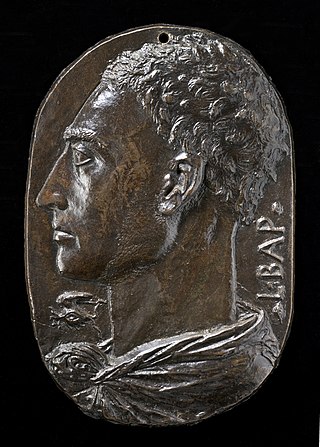
Leon Battista Alberti was an Italian Renaissance humanist author, artist, architect, poet, priest, linguist, philosopher, and cryptographer; he epitomised the nature of those identified now as polymaths. He is considered the founder of Western cryptography, a claim he shares with Johannes Trithemius.
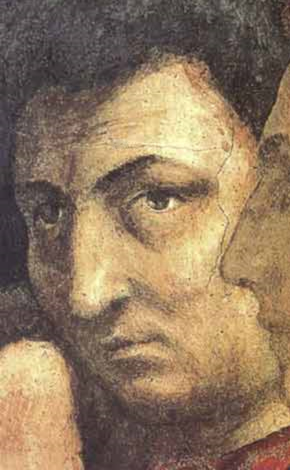
Masaccio, born Tommaso di Ser Giovanni di Simone, was a Florentine artist who is regarded as the first great Italian painter of the Quattrocento period of the Italian Renaissance. According to Vasari, Masaccio was the best painter of his generation because of his skill at imitating nature, recreating lifelike figures and movements as well as a convincing sense of three-dimensionality. He employed nudes and foreshortenings in his figures. This had seldom been done before him.
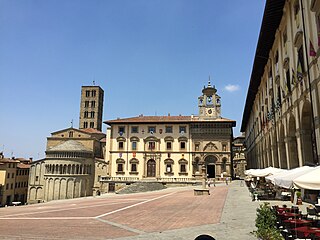
Arezzo is a city and comune in Italy and the capital of the province of the same name located in Tuscany. Arezzo is about 80 kilometres southeast of Florence at an elevation of 296 metres (971 ft) above sea level. As of 2022, the population was about 97,000.
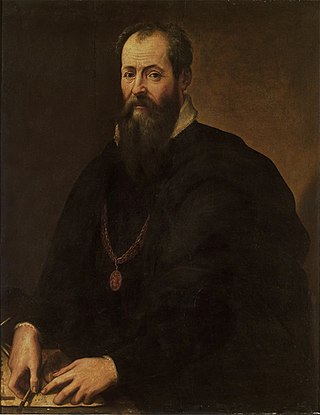
Giorgio Vasari was an Italian Renaissance painter and architect, who is best known for his work The Lives of the Most Excellent Painters, Sculptors, and Architects, considered the ideological foundation of all art-historical writing, and still much cited in modern biographies of the many Italian Renaissance artists he covers, including Leonardo da Vinci and Michelangelo, although he is now regarded as including many factual errors, especially when covering artists from before he was born.

Luca Signorelli was an Italian Renaissance painter from Cortona, in Tuscany, who was noted in particular for his ability as a draftsman and his use of foreshortening. His massive frescos of the Last Judgment (1499–1503) in Orvieto Cathedral are considered his masterpiece.

The Palazzo Vecchio is the town hall of Florence, Italy. It overlooks the Piazza della Signoria, which holds a copy of Michelangelo's David statue, and the gallery of statues in the adjacent Loggia dei Lanzi.

Silvio Passerini was an Italian cardinal.

Stradanus, Johannes Stradanus, Jan van der Straet or Giovanni Stradano was a Flemish artist active mainly in 16th-century Florence, Italy. He was a wide-ranging talent who worked as an easel and fresco painter, designer of tapestries, draughtsman, designer of prints and pottery decorator. His subject range was varied and included history subjects, mythological scenes, allegories, landscapes, genre scenes, portraits, architectural scenes and animals. After training in his native Flanders, he left his home country and ultimately settled down in Florence, Italy. He became a prominent court artist to the Medici during the second half of the 16th century and worked on the many decorative projects of the court. Stradanus also produced large altarpieces for the most important churches in Florence.

Jacopo Vignali was an Italian painter of the early Baroque period.
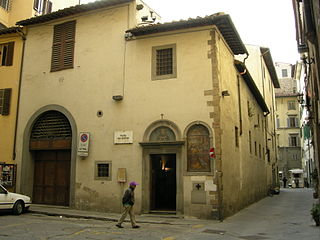
San Martino del Vescovo, also known as the Oratorio dei Buonomini di San Martino, is a Roman Catholic parish church, located in the small piazza of the same name in Florence, Italy.

Andrea del Sarto was an Italian painter from Florence, whose career flourished during the High Renaissance and early Mannerism. He was known as an outstanding fresco decorator, painter of altar-pieces, portraitist, draughtsman, and colorist. Although highly regarded during his lifetime as an artist senza errori, his renown was eclipsed after his death by that of his contemporaries Leonardo da Vinci, Michelangelo, and Raphael.

The Stories of St. Stephen and St. John the Baptist is a fresco cycle by the Italian Renaissance painter Filippo Lippi and his assistants, executed between 1452 and 1465. It is located in the Great Chapel of the Cathedral of Prato, Italy.
Arcangela Paladini was an Italian painter, singer and poet.
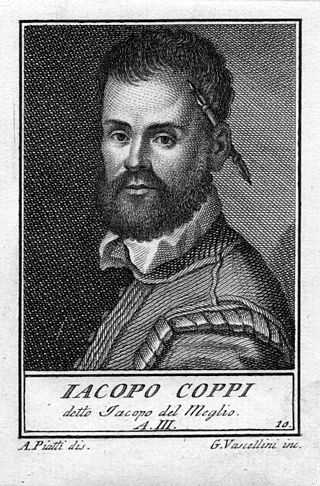
Jacopo Coppi, also called Giacomo Coppi or "'Jacopo del Meglio'" was an Italian painter, mainly active in Florence and Rome in a Mannerist style. Other sources call him Giacinto Coppi.

Monastero delle Murate is a former Benedictine convent on Via Ghibellina in Florence, Italy. For about a hundred years, from 1883 to 1985, it was the men's prison in Florence, after which the detainees were transferred to Sollicciano and other facilities. Since the 21st century, it has served as a restaurant and meeting places, with additional apartments, bars, restaurants and shops. The religious community dates to 1370 when 12 women became voluntarily reclusive in a shack by the second pillar of the Ponte Rubaconte, praying and living on alms in extremely difficult conditions. Given the growth in the number of sisters, in 1424, Giovanni de 'Benci, who lived nearby, financed the construction of a new, larger monastery near the walls, called the Most Holy Annunciation and St. Catherine. The monastery was renovated and expanded for the first time in 1471, following a fire, and then in 1571, after a flood. Supporters included Lorenzo de' Medici. Also in 1509 Caterina Sforza was buried in the monastery.
There are several portraits of the Italian goldsmith and sculptor Benvenuto Cellini (1500–1570). Including self-portraits and portraits of him by other artists. Benvenuto Cellini's physical appearance is determined based on a number of his lifetime portraits. However, due to a few known portraits from the 17th – 20th century, where the artists drew Cellini's facial traits from their imagination, as well as because of past posthumous erroneous attributions, there is a level of confusion on this subject.
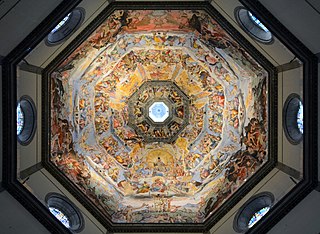
The Last Judgment in the Cattedrale di Santa Maria del Fiore, in Florence, Italy is a fresco painting which was begun by the Italian Renaissance master Giorgio Vasari in 1572 and completed after his death by Federico Zuccari, in 1579. Initially commissioned by Grand Duke Cosimo I de' Medici, it is located on the ceiling of the dome of the cathedral. It was the subject of an extensive restoration undertaken between 1989 and 1994.

The Casa Vasari is a building at 55 via XX Settembre in Arezzo, Tuscany, Italy. It was the family home of the painter, art historian and architect Giorgio Vasari. It houses a number of frescoes and since December 2014 the Italian Ministry of Culture has run it through the Polo museale della Toscana, which was renamed the Direzione regionale Musei in December 2019. It houses the Archivio Vasariano.

Palazzo Bezzoli, or Del Bembo or Martelli, is a civic building in the historical centre of Florence, located between via dei Cerretani 11r-13r-15r-17r-19r and piazza dell'Olio 3. The palazzo appears in the list drawn up in 1901 by the General Directorate of Antiquities and Fine Arts, as a monumental building to be considered national artistic heritage (Italy).

Palazzo Caccini is located in Florence at Borgo Pinti 31–33, on the corner of Via Nuova dei Caccini.
























